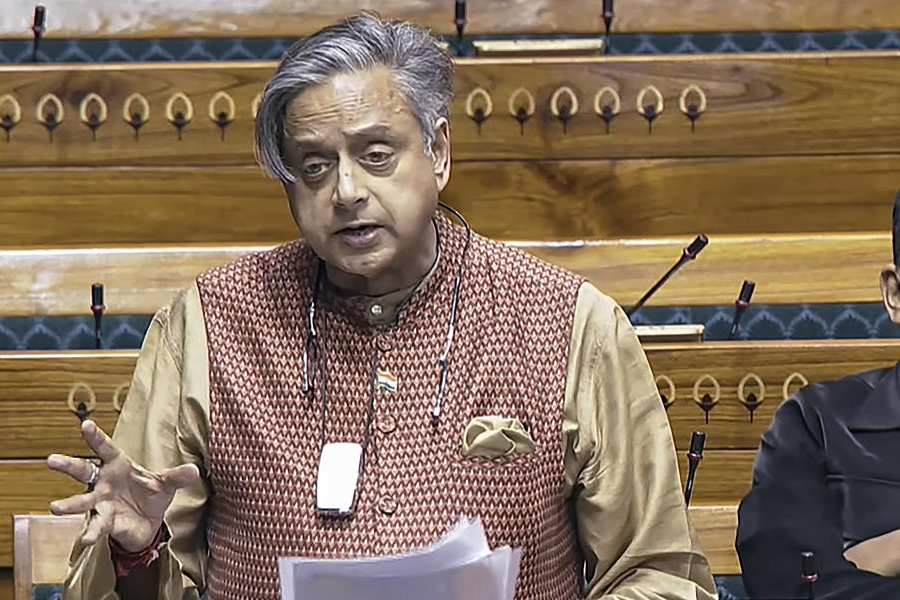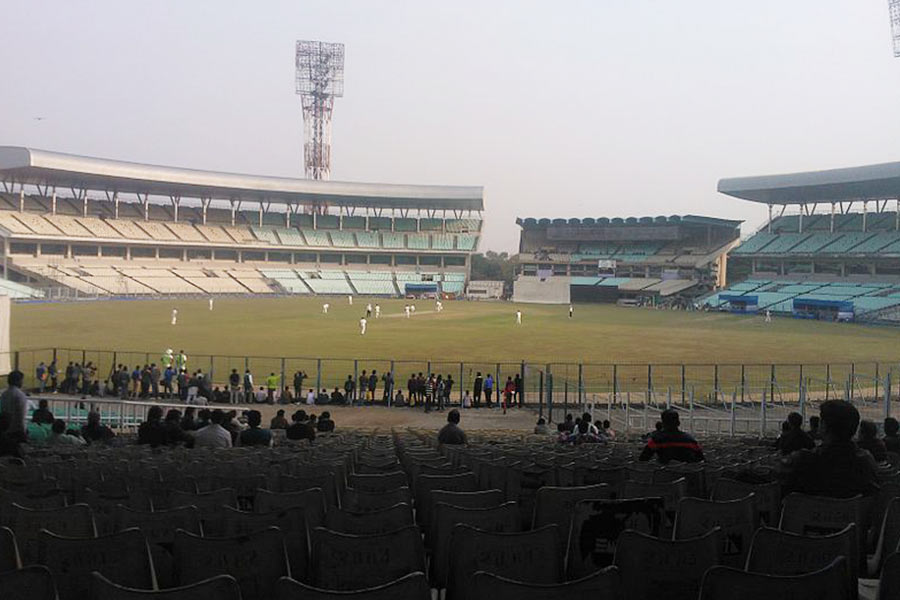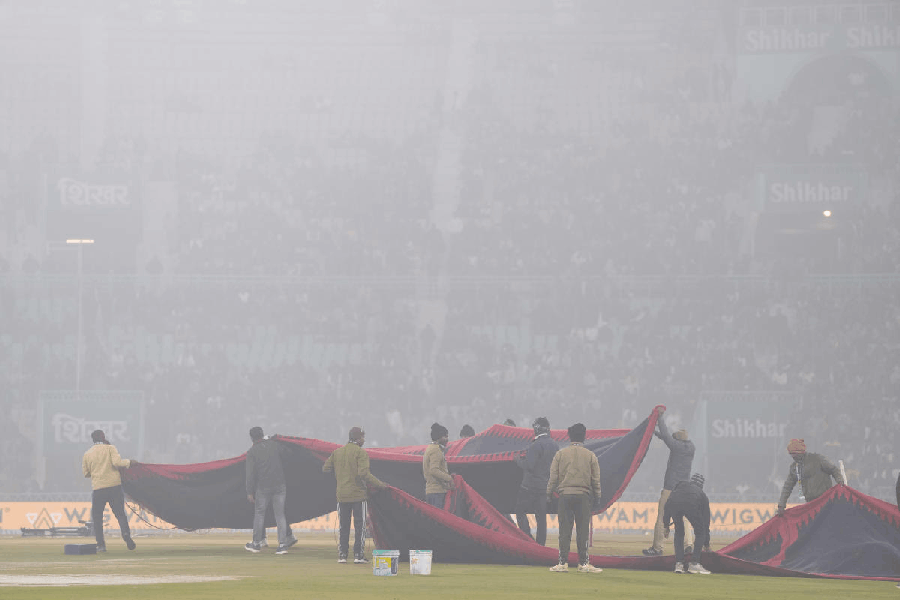 |
| TESTING TIMES: Nandita Narain, a Delhi University lecturer, takes a class outdoors to protest the decision to implement the semester system |
The sun’s rays are scorching, but the lecturer seems undaunted by the heat. With her sunglasses on, Nandita Narain is scribbling on a board carefully placed on a small table. Students of mathematics sit around her on newspapers spread on the ground, attentively taking down notes.
A stone’s throw away, another lecture is in progress. The professor of economics is also addressing his students out in the open.
These are not rural classrooms or alternative educational sites, but regular classes conducted by teachers affiliated to Delhi University (DU). Lessons are being held on the lawns of the university, just opposite the vice-chancellor’s (VC) office. The exercise, held over several days in mid-March, is in protest against the university’s determination to introduce a semester system in colleges.
“I hope I don’t get a heat stroke by the evening,” jokes Narain, who teaches at St Stephen’s College. She has already finished three lectures since the morning and has taken a quick lunch break. “The semester system is simply a mind-crippling activity. We don’t mind this heat as long as we get heard,” she adds before getting ready for her next class.
All across the country, education is in a state of flux. The old system of teaching — in place in hundreds of colleges for decades — is going for a toss. The new system announced by the government won’t just radically change the face of education but has divided the teaching fraternity.
If a large section of teachers is against the change, another lot has welcomed it. Earlier this month, heads of nearly 40 universities from across India met at Jadavpur University in Calcutta to discuss a provision in the new system which allows students to pursue a course in two institutions.
With the semester system, the government seeks to overhaul methods of learning in undergraduate studies. Once put into effect, writing 10 or 12- odd papers over a span of a fortnight at the end of an academic year would be a thing of the past. A syllabus will be broken into small parts which will be taught in specified time periods allotted to each topic.
It all started in 2009 when the University Grants Commission wrote to central, state and deemed universities pressing for the introduction of a semester and choice-based credit system (CBCS). Under this system, universities are to follow teaching and assessment in a semester pattern. Minimum credits (see box) for each subject are to be maintained and grades adopted for marking students.
“The system will be introduced in a phased manner and will give students more options,” says Dinesh Singh, vice-chancellor of Delhi University, where it has already been in place for 13 science subjects since the last academic session. “Things are beginning to work out. There is no arm twisting and I am open to discussions with teachers,” Singh adds.
Supporters of the new structure believe it is student-friendly as it enables continuous learning and assessments. Once CBCS is fully implemented, applying to foreign universities and inter-university transfers will become easier. The new system also allows inter-disciplinary choices — a biotechnology student, for instance, can opt for music in one semester.
But others see it as geared towards examinations and against in-depth learning. “It’s more of a rigid exam-oriented system than a teaching-learning process,” argues Saumyajit Bhattacharya, an economics lecturer at Kirori Mal College, Delhi University.
There’s more. The structure for devising courses and conducting examinations is still unclear. Worse still, the protestors argue, is the fact that the course content gets diluted because of the inclusion of more subjects. “Instead of knowing everything about everything, we are just happy knowing something about everything,” says Kaustubh Panda, head of the department of biotechnology, Calcutta University (CU).
Delhi’s Jamia Milia Islamia University, which had planned to introduce the system in 2011-2012 for its undergraduate courses, has now delayed it by a year.
Though most postgraduate departments in CU have already switched to semesters, implementing them at the undergraduate level still remains an issue. In some courses, students are being taught in semesters, though examinations are being held annually as before.
“It is absolutely impossible to have a semester system for undergraduate studies in the present scenario,” says Suranjan Das, vice-chancellor, CU. “I have nothing against the semester system but where is the infrastructure to support the changes in our university,” asks Das.
While some object to the system itself, others like Das believe it’s not feasible. He cites a skewed student-teacher ratio and the insufficient number of libraries as the prime problems in implementing the reforms. “The semester system would help only privileged students who have access to resources,” says Das.
But while teachers are throwing up their hands in despair, the system seems to have been put into effect rather smoothly in some corners of the country. Kerala, for one, has successfully implemented CBCS in all its universities.
Kannur University, Kerala, was the first in the state to introduce a grading system in 2009. “We too faced initial resistance from teachers,” says pro vice-chancellor Kuttykrishnan A.P. But the system, he adds, started working once faculty positions were filled. Last year, around 1,500 lecturers were appointed in universities across Kerala.
Kuttykrishnan believes the new system promotes learning. “Previously there was an academic drought as studying was concentrated in the last four or five months before the exams. But now it’s a continuous process,” he says.
The system, indeed, focuses on a process where learning and teaching continue through the year on an even keel. It does not encourage rote learning, but emphasises projects, assignments and seminars that are constantly evaluated. The semester system combined with credits facilitates inter-university transfers.
For an effective switchover, universities in Kerala have been organising rigorous training of teachers, curriculum revision and seminars. “It’s not just breaking the syllabus into two and going ahead with two exams,” says K.N. Panikkar, vice-chairman of the Kerala State Higher Education Council (KSHEC), which was formed in 2007 to look into academic reforms in Kerala. “We are dealing with the reorganisation of the syllabus with a multi-disciplinary approach.”
KSHEC partnered with Pearson Education India for curriculum revision and teacher training. Books explaining the process were published. “We started with curriculum development, followed by creating content from scratch based on the needs of individual courses and gave assessment techniques as well,” says K. Srinivas, assistant vice-president and publisher, Higher Education, Pearson Education. “This was then followed by teacher training workshops across Kerala.”
The Council, Panikkar adds, conducted 50-100 workshops in every college in Kerala. “The change didn’t happen overnight,” he says.
Proponents stress the system is not new to India. Some of the top institutions in the country — including the Indian Institutes of Technology, Birla Institute of Technology and Sciences, Pilani, and Indian Institute of Science — follow semesters. All the 15 new central universities which started their academic session last year have the same system.
“We have been following the grade-credit-semester system since the inception of our university in 1950,” says Uma Joshi, dean, faculty of Family & Community Sciences, M.S. University, Baroda. As part of CBCS, the faculty has now designed 23 new courses which students can opt for from the new academic session.
Some teachers too are voicing their support. “Undoubtedly, it is a student-friendly system because of internal assessments, constant evaluations and compact forms of studying,” says Bipul Malakar, professor of economics, Jadavpur University.
Lecturers at Delhi University, however, believe that the system is being thrust upon them. Some whisper that pressures from the West are at work. A new bill proposes to open up the higher education sector to foreign universities and the credit and semester system is seen as a way to boost student movement into foreign universities. Placards on the Delhi University lawns on the public teaching days highlighted the links with the West. Who’ll benefit, asked one placard, students or the West?
But supporters believe the system is being opposed by lecturers who are unwilling to change. “No one wants to change their comfortable positions,” says Deepak Pental, former Delhi University vice- chancellor under whose tenure the system was first implemented. “Except for British universities, semesters are followed almost everywhere in the West. So how can we argue it isn’t worthwhile? Perhaps it would mean more work for teachers. It just shows a lack of commitment and the quest for mediocrity,” he adds.
Author and columnist Gurcharan Das is a staunch advocate of semesters. “For students, the idea of inter-disciplinary subjects is wonderful. I could survive Harvard University for four years because of the ease with which I could change disciplines,” he says. Das joined the university for engineering, then moved to study chemistry, later picked up economics, history, literature, Sanskrit, architecture and eventually majored in philosophy. “We should move away from our narrow-tunnelled vision,” he adds.
It’s the vision that’s in dispute. And for the time being at least, there is no clear picture.
Semester basics
■ Semesters are of six months’ duration, and examinations are held at the end of each semester.
■ Credits are points given to a course, usually in relation to the instructional hours assigned to it. For instance, a six-hour course a week gets four credits, four or five hour courses three credits and two hour courses two credits. The minimum number of credits required for completing an undergraduate programme is 120.
■ Students are permitted to transfer their course credits from one university to another.
The good and the bad
Pros
■ It engages both the faculty and students through the year in academic activity.
■ Students can choose subjects in other disciplines, move from one university to the other — domestic and foreign — in the middle of a course.
■ They have to study for 24 papers. About 15 papers would deal with the major subject.
■ Universities notorious for late results will now have to declare results faster.
Cons
■ Leads to subjectivity as a teacher may have too much say in the academic performance of students.
■ In theory, the semester system revolves around reading lists and libraries, as teachers are expected to introduce the topics in class and direct students to an exhaustive list of books to be read. Lack of infrastructure in most universities will cause problems.
■ Learning may not be in-depth.










